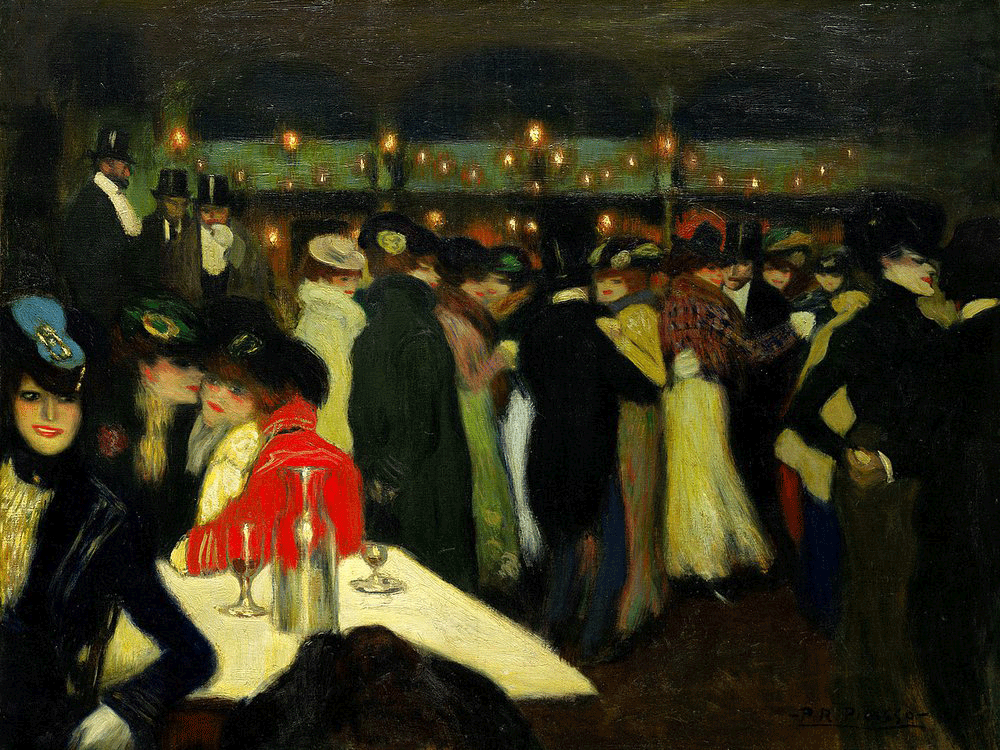Small Dog Wearing Red Bow Found Hidden in Picasso Painting
The Spanish painter decided against keeping the cute canine in the foreground of “Le Moulin de la Galette”

Near the bottom left corner of Pablo Picasso’s Le Moulin de la Galette (1900), a brown mass, perhaps a coat, is draped over a chair in the titular dance hall. Upon closer inspection, however, this spot reveals the outline of a head and ears—a furry friend who once joined the revelers.
“If you look closely, you can see that there’s this lingering ghost of the dog,” says Julie Barten, senior paintings conservator at the Guggenheim Museum in New York City, to Reuters. “There’s red paint showing through. In areas, if you look really closely, you can see the eyes here and the ears here. And you can see that, in concealing it, he actually left the contour of the top of the head still visible.”
Now, only the outline of the painted-over pooch remains. However, thanks to imaging done in the lead-up to the Guggenheim’s “Young Picasso in Paris” exhibition, curators are able to approximate what the little dog might have looked like before being turned into a coat.
“Scanning X-ray fluorescence maps the distribution of elements contained in the painting, including inorganic pigments,” Barten tells Hyperallergic’s Rhea Nayyar. “The image of the dog is a false-color visualization that was generated by mapping the distribution of the pigments vermillion red, zinc white and iron-containing ochres.”
/https://tf-cmsv2-smithsonianmag-media.s3.amazonaws.com/filer_public/a6/fc/a6fccf8b-e66f-4402-b74d-f3d5596683d0/screen_shot_2023-05-17_at_102348_am.png)
What this scanning revealed was the furry form of what appears to be a Cavalier King Charles spaniel sporting a little red bow around its neck. “It was interesting to me that he hastily painted over this dog, which would have been a rather compelling aspect of the composition,” Barten says to CNN’s Lianne Kolirin and Jacqui Palumbo.
Some experts wonder whether Picasso found the dog to be too compelling—and, perhaps, distracting.
“By eliminating the dog, Picasso focuses more attention on the figures and the space,” Megan Fontanella, curator of the Guggenheim exhibition, tells Hyperallergic. “One may now observe how nuanced the act of looking unfolds in Le Moulin de la Galette, with patrons of the dance hall casting their eyes in various directions.”
Tom Williams, an art historian at Belmont University in Nashville, tells the New York Times’ Jesus Jiménez that removing the dog was the right move. “It’s hard to imagine this particular painting with a dog in the foreground,” he says. “I’m not sure a dog, and particularly a lap dog, makes sense in the dark, uneasy and erotically charged atmosphere that Picasso conjured up so brilliantly in this picture.”
Broadly speaking, Picasso was known to make changes midway through a piece. Several works from the artist’s Blue Period contain hidden compositional elements: While working on The Soup (1902), Picasso painted over several rejected elements, including a woman with her back to the viewer. He also painted over a disclike shape held by the subject of The Crouching Beggar (1902), a piece that was itself painted atop a previous landscape.
The dog’s disappearance wasn’t the only change Picasso made to Le Moulin de la Galette. The artist also switched the gender presentations of a couple on the dance floor and painted out an empty chair, according to CNN.
“We see, more and more, that this was part of Picasso’s working process,” says Barten to CNN. “As he developed a composition, he would paint out certain elements, or transform them into new compositional details. And, very often, he would leave aspects of the underlying original compositions still evident to a viewer who was looking very closely.”
“Young Picasso in Paris” is on view at the Guggenheim Museum in New York City through August 6, 2023.
/https://tf-cmsv2-smithsonianmag-media.s3.amazonaws.com/accounts/headshot/Teresa_Nowakowski.png)
/https://tf-cmsv2-smithsonianmag-media.s3.amazonaws.com/accounts/headshot/Teresa_Nowakowski.png)